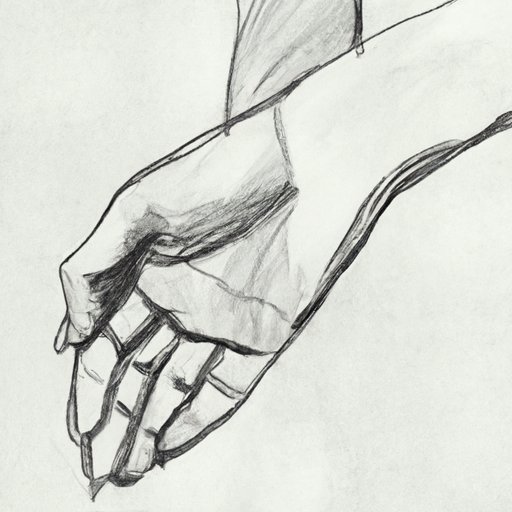Introduction
Most beginner artists often find it challenging to draw hands accurately. The complexity of the hand’s structure and the different angles and poses make it a difficult subject to master. However, hands are an essential subject to learn how to draw because they play a crucial role in conveying emotions and actions in human figures. In this article, we will provide a step-by-step guide, techniques, and exercises to help you improve your hand drawing skills.
Handy Tips for Drawing Hands: A Step-by-Step Guide for Beginners
When drawing a hand, the first thing to consider is its proportion and detail. Observing the hand’s position and angle will greatly help in getting the right proportions. You can sketch the hand’s shape by drawing basic shapes for the fingers and the palm. After this, start refining the details, such as the creases, fingernails, and joints, to make the drawing more realistic.
When drawing different hand poses, it’s important to keep in mind the hand’s flexibility and range of motion. You can practice by observing your own hand and copying its position. Moreover, you can also use photo references or draw from a model to help you understand and visualize the hand’s anatomy better.
Unleash Your Inner Artist: Mastering the Art of Drawing Hands
Aside from its practical use in human figures, learning how to draw hands can also improve your overall drawing skills. It trains your hand and eye coordination in observing shapes, shadows, and proportions. Moreover, it can also serve as a therapeutic activity, helping you express yourself through art.
Practice is key to mastering the art of drawing hands. Don’t hesitate to experiment with different techniques and styles. You can look up different hand drawings by artists as inspiration and study their techniques. With constant practice and experimentation, you can develop your own unique style.
Breaking It Down: Understanding the Anatomy of Hand Drawing
Before drawing a hand, it’s important to understand its anatomy. Each finger has three bones, while the thumb has two, with muscles that control their movement. Moreover, tendons and ligaments attach muscles to the bones, helping the hand move accordingly. Understanding how these structures work together will help you draw hands more accurately.
When drawing the bones, muscles, and tendons of the hand, start by drawing basic shapes that represent the different parts. This can help in knowing their position in relation to each other. Afterward, start adding the details such as creases, tendons, and joints to give the drawing volume and depth.
From Basics to Pro: Essential Techniques for Drawing Hands
Shading and adding texture are essential techniques in creating realistic-looking hand drawings. To add depth and dimension to your drawings, start by drawing the basic shapes and then applying shadows to create a sense of volume. You can use techniques such as cross-hatching and stippling to enhance the texture of the hand.
Creating realistic-looking skin texture is also crucial when drawing hands. You can experiment with different shading techniques and use a reference to observe the skin’s changes in color and texture, especially in areas where the skin bends or stretches.
Hands-on Practice: Exercises to Improve Your Hand Drawing Skills
Exercises are important in improving your hand drawing skills. You can start with basic exercises such as drawing different hand poses repeatedly. Doing this will help you develop muscle memory and train your hand to draw more accurately. You can also try drawing your hand from different angles or positions to better understand its structure and flexibility.
Moreover, you can also use photo references or draw from a model to help you understand and visualize the hand’s anatomy better. Don’t be afraid to make mistakes and experiment with different techniques. With constant practice, you can see a significant improvement in your hand drawing skills.
The Power of Observation: Tips for Drawing Realistic Hands
Observation is crucial in drawing realistic hands. To deepen your understanding of the hand’s structure and movements, you can observe hands in real life and take note of their positions and angles. You can also use a camera to capture hands in different poses and use the photos as reference when drawing.
In drawing from photos, it’s essential to analyze the lighting and shadows to understand how they affect the hand’s appearance. Moreover, take note of the highlights and reflections in the skin to make the drawing more lifelike.
Conclusion
Drawing hands can be challenging, but with proper understanding and practice, you can master the art of drawing them. We provided you with a step-by-step guide, techniques, and exercises to help you improve your hand drawing skills. Keep in mind the importance of proportion and detail, and don’t forget to practice regularly.
